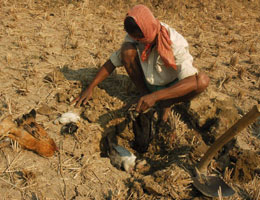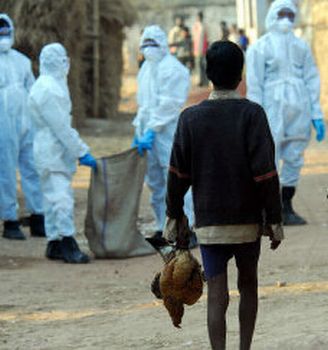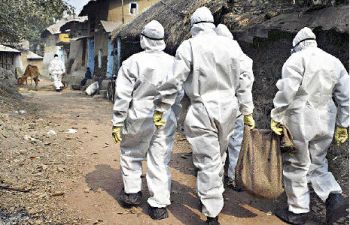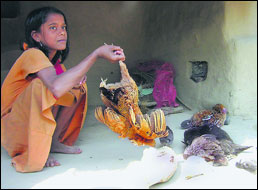Entries in Politics and government (199)
Taking on the H5N1 naysayers
 My favorite punching bag, OIE's head Bernard Vallat, has been conspicuously silent since things went to Hell in a handbasket regarding the global spread of H5N1 a few weeks ago. Maybe he has been reading his own organization's daily reports of the culling of what is now more than a million Indian chickens. Or maybe he has been reading about the collapse of the West Bengal poultry industry. Or maybe he has read the words of prominent virologists who said Vallat's statements were "naive and dangerous -- and widely acknowledged as such among vaccinologists."
My favorite punching bag, OIE's head Bernard Vallat, has been conspicuously silent since things went to Hell in a handbasket regarding the global spread of H5N1 a few weeks ago. Maybe he has been reading his own organization's daily reports of the culling of what is now more than a million Indian chickens. Or maybe he has been reading about the collapse of the West Bengal poultry industry. Or maybe he has read the words of prominent virologists who said Vallat's statements were "naive and dangerous -- and widely acknowledged as such among vaccinologists."
That should also serve notice to Dr. Paul Offit, who recently boasted to New York Times' correspondent Donald G. McNeil that, in essence, H5N1 would never go pandemic. In McNeil's recent fair and balanced article, titled "A Pandemic That Wasn't But Might Be,"
Dr. Paul A. Offit, a vaccine specialist at Children’s Hospital in Philadelphia, was one of those who, he jokes, “dared to be stupid” by bucking the alarmist trend in 2005.
“H5 viruses have been around for 100 years and never caused a pandemic and probably never will,” he said.
But Dr. Offit said he backed all preparedness efforts because he expected another pandemic from an H1, H2 or H3, the subtypes responsible for six previous epidemics, including the catastrophic one in 1918.
“What I worry is that this has been a ‘boy who cried wolf’ phenomenon,” he said. “When the next pandemic comes, people will say, ‘Yeah, yeah, we heard that last time.’ ”
http://www.nytimes.com/2008/01/22/science/22flu.html
Now, I am not personally aware of any record of H5 viruses being typed at all prior to 1959's Scotland discovery. And if scientists are still divided about what caused the 1890 pandemic --was it an H2 or H3 virus, or something completely different? -- then I don't think Offit can flatly state that H5 has been circulating over the past hundred years. Don't get me wrong: I respect Offit, and am currently reading a copy of his book Vaccinated, which chronicles the amazing life of Dr.Maurice Hilleman (see my post, titled Will H2N3 reassortant prove Maurice Hilleman correct? ).
 But I respect Dr. Gregory Poland more. Dr. Poland (pictured) is one of the world's leading vaccinologists -- a peer of Offit's -- and basically runs the vaccine program at the Mayo Clinic. He is also a world-class expert on the emergence of the H5N1 virus, and is deeply concerned with emerging world events. You might also recognize Dr. Poland from his appearance on this past summer's BBC docu-drama "Pandemic." Believe me, he had some choice words for Monsieur Vallat's recent comments about H5N1 being "stable" and H5N1 pandemic fears being "overblown"!!
But I respect Dr. Gregory Poland more. Dr. Poland (pictured) is one of the world's leading vaccinologists -- a peer of Offit's -- and basically runs the vaccine program at the Mayo Clinic. He is also a world-class expert on the emergence of the H5N1 virus, and is deeply concerned with emerging world events. You might also recognize Dr. Poland from his appearance on this past summer's BBC docu-drama "Pandemic." Believe me, he had some choice words for Monsieur Vallat's recent comments about H5N1 being "stable" and H5N1 pandemic fears being "overblown"!!
I wish someone would ask Dr. Poland for his opinion of Dr. Offit's claim that H5 has been around for a hundred years and will never go pandemic. Maybe H5 has been around for a thousand years! How long a virus has been festering in the intestines of flying birds is irrelevant. It is how long the virus has shown a proclivity for human tracheas and lungs -- that is the question. And for humanity, H5 in humans -- as far as anyone knows for certain -- has only been around for eleven years. Not a hundred. And not a thousand.
It is like saying that the SARS virus has been hanging around in the blood of civet cats for a hundred years, so why worry? let's ask the 8,000 people who caught SARS in 2003 -- minus the 800 or so who died -- ask them if it mattered that SARS was no biggie for 99 of those 100 years.
I also appreciated the remarks of Dr. Mike Osterholm, standard bearer in the fight against what he has coined "Pandemic Fatigue." Osterholm, also in the NYT article, "noted that the H3N8 flu found in horses in the 1960s took 40 years to adapt to dogs, but that since 2004 it has spread to kennels all over the country."
Influenza smoulders. It finds its own way, and on its own timetable.
Offit belongs to that group of people who believe that only H1, H2 and H3 viruses will ever cause a pandemic -- the theory of recycled pandemic strains of influenza. Personally, as I mentioned earlier, I am not sure if anyone can say with any degree of certainty that H1, H2 and H3 have caused any more pandemics than the three that have been positively typed by researchers. After all, influenza has only been typed with certainty in the past fifty years or so. How anyone can say that these three strains were responsible for 1832, even 1847 or 1890, without supporting genetic material, is a stretch.
Offit's claim in the book about Hilleman is that Hilleman was able to find H2 antibodies in elderly people who lived through the 1890 pandemic. Therefore, Hilleman claimed (and Offit parrots), the 1890 pandemic must have been an H2 strain. The 1900 outbreak was an H3, reckoning by the 68-year clock Hilleman/Offit claimed exists (I can find no evidence of a 1900 pandemic, bu the way). Using that 68-year calculation mechanism, the pandemic of 1847-48 would have been H1.
But wait! Adding 68 to 1847 equals 1915. Close enough; let's run with it. And if we know that the 1918 pandemic was an avian flu that jumped straight to humans (we do), as Dr. Jeffrey Taubenberger of the US Armed Forces Pathology Lab genetically proved (with an assist by Dr, Johan Hultin, one of the Unsung Heroes of influenza research), then wasn't that a novel virus? Wasn't that something that had never been seen before? Unless that jump had happened before then as well.
So what does this do to the Hilleman/Offit theory if it turns out that this adaptive mutation route is really the cause of the more lethal pandemics, and reassortment , while being a pandemic incubator as well, actually is the more prevalent yet the less likely to kill? I'll tell you what it does. It kills it Black Flag Dead.
Indonesia about to reach grim milestone in bird flu fight
 It is hard to imagine any situation anywhere in the world knocking India off the Bird Flu Radar. But it has happened. And it is our old friend Indonesia that has caused the temporary shift in global bird flu attention.
It is hard to imagine any situation anywhere in the world knocking India off the Bird Flu Radar. But it has happened. And it is our old friend Indonesia that has caused the temporary shift in global bird flu attention.
While much of the world's attention (as well as my own attention) was focused on the events in West Bengal, quietly the situation in Indonesia was worsening as well. But while there are no confirmed human cases of H5N1 in India to date, the exact opposite is happening in Indonesia, where no less than three people have tested positive for H5N1 in the past week -- and a fourth test is probably a fait accompli.
This sudden increase in H5N1 cases and deaths makes it literally a matter of days -- maybe hours -- before Indonesia reaches the 100-death level from H5N1. That is a distinction that the country certainly does not want, but cannot avoid.
From today's Reuters wire:
Indonesia boy dies of bird flu, making death toll 99
JAKARTA, Jan 28 (Reuters) - A 9-year-old Indonesian boy who had tested positive for bird flu died on Monday, the health ministry said in a statement, taking the country's death toll from the deadly disease to 99.
The boy from the outskirts of Jakarta died at the Sulianto Saroso hospital on Sunday after being treated in different hospitals for two weeks, said Joko Suyono, an official at the ministry's bird flu information centre.
It was not known how the boy contracted the disease.
Indonesia has had the highest number of human deaths from bird flu of any country.
A 31-year-old woman and 32-year-old man hospitalised at Persahabatan hospital for fever and respiratory problems also tested positive for the deadly H5N1 virus on Monday, the ministry said.
According to the statement, the woman lived in East Jakarta near a poultry slaughterhouse that kept many fowl believed to be the source of her H5N1 infection.
The man from Tangerang, west of Jakarta, is believed to have contracted H5N1 from his neighbour's pet doves, the ministry said.
Contact with sick fowl is the most common way of contracting bird flu, endemic in bird populations in most of Indonesia.
Although bird flu remains an animal disease, experts fear the virus could mutate into a form easily passed from human to human and kill millions.
Authorities are also expecting genetic test results to come back for a fourth case, a 23-year-old housewife from East Jakarta, who died on Sunday from bird flu symptoms.
Suyono said there are no obvious explanation for the sudden surge of cases. "We need to carry more tests and investigation first to be really sure." (Reporting by Adhityani Arga; Editing by Sugita Katyal and Jerry Norton)
There have also been reports of scores of Indonesians being sent to hospital with bird flu symptoms. Fortunately, and as is usually the case, most people test negative for H5N1 and are sent home. After all, Indonesia is a regular Wal-Mart of infectious disease, including dengue, chikungunya, malaria, you name it. And thousands of people are afflicted and die annually from the aforementioned maladies.
But it's the H5N1 positives -- and the location of the positives -- that tell the complete story. As you can see from the (above) excellent map of Indonesian human H5N1 cases maintained by intrepid flu poster Dutchy, there are areas where H5N1 is not just indigenous in poultry -- the disease has taken a liking to infecting humans in significant numbers as well,
The four new human cases are distributed as follows: One from East Jakarta; one from West Jakarta; one from Tangerang, which has been the subject of several of my posts over the past few months; and one from West Java.
What also appears to be happening is that the Case Fatality Rate in Indonesia seems to be inching higher.
In the meantime, Vietnam has also reported a new case of H5N1 -- and death -- in a 32-year old male, located about fifty miles northwest of Hanoi. Fujian H5N1 (Clade 2.3 or 2.3.4, if you prefer) is suspected.
In the meantime, India is importing enough Tamiflu to make Roche's quarter, and there is absolutely no end in sight to the infestation of poultry in the region, which includes neighboring Bangladesh. China is culling birds again by the tens of thousands, and Thailand and Turkey are again reporting infestations of H5N1 in poultry.
When the media reports began to appear, talking about the "milder" bird flu situation, I think many of us scoffed openly at any insinuation that H5N1 was receding from either the bird population or the potential for pandemic. Now, in just a few weeks, H5N1 has absolutely exploded back upon the world scene.
Goats dying by the score in Birbaum from mystery disease
 Intrepid readers:
Intrepid readers:
My last post, titled "This is how a pandemic might begin..... 2,300 complain of fever in Birbhum, West Bengal :, is now accompanied by a companion piece -- about the sudden and totally unexpected deaths of more than 100 goats, in the same area.
From today's Times of India, just a few moments ago:
Flu panic rises as goats drop dead
25 Jan 2008, 0223 hrs IST![]() ,
,![]() Caesar Mandal
Caesar Mandal![]() ,
,![]() TNN
TNN
|
MARGRAM (BIRBHUM): Hundreds of goats have died of an unknown disease over the past four days in Birbhum's Rampurhat block II.
Some experts warned that if the H5N1 virus — which causes bird flu — has jumped from birds to mammals, it could be the turn of humans next. TOI met jittery villagers in Dakhalbati, one of the affected villages in Birbhum's Margram. Abdul Mohid, a farmer, said his goat was shivering and sneezing and saliva was oozing from its mouth. Mohid had called in a local vet, who could only say the animal was suffering from high fever but could not pinpoint a disease. Though he prescribed medicines, those have not worked. Mohid, who has already lost 35 chickens to bird flu, is now scared about his livestock. He said that several neighbours had lost their goats as well to the mystery ailment. His neighbour Seikh Kalim has buried seven goats over the past two days. They were suffering from a similar disease. In their case, too, drugs prescribed refused to work. The animals had fever and their throats started swelling before they fell unconscious and died within minutes. At Dakhalbati, more than 60 goats have died so far. Villagers are blaming bird flu, as the symptoms are similar. But the state administration has claimed there was no information of cattle dying in the district. "It could be pneumonia, which commonly affects goats. But an H5N1 attack is not impossible. Pigs are proven carriers and since these goats have been sharing space with the affected birds, they are vulnerable. Chances of humans contracting the disease can't be ruled out," said Shyamalendu Chatterjee of the Indian Council for Medical Research. Others like Barun Roy, an animal diseases expert, pointed out that H5N1 was yet to affect cattle anywhere in the world. "It is unheard of. The goats must have been suffering from pneumonia," Roy said. The state administration, too, has claimed it had no information of goats dying in the district. Bird flu has resulted in huge financial losses for the villagers. They are not happy with the compensation. Now, most are trying to sell off their goats. "I have sold three goats at a low price. If this disease is bird flu, goats would be killed and I would lose my entire investment," said Mohammad Motier Rahaman, who lost three goats in two days. Reports of hundreds of goats dying have also come in from Murshidabad's Khargram and Beldanga areas. |
This is serious stuff, even if it is unrelated to avian influenza. Note the speed with which the landscape has changed in just the past twenty-four hours. Note that it feels like we have been talking Indian H5N1 for weeks, when really the stories just started coming in ten days ago.
This is how the start of a pandemic will make its presence known to us. A few scattered media accounts, unconfirmed and unsubstantiated at first; then, suddenly, more and more specific reports will appear. Finally, and with a crushing blow, the outbreak will happen. And this is why we must continue to remain vigilant. Because if H5N1 has crossed the species barrier again, and gain a foothold in Indian goats as well as wild birds and poultry, we will have another endemic reservoir of avian flu -- this time, located in the second most populous nation in the world. And H5N1 will have significantly increased its chances of going pandemic.
As Dr. Henry Niman is fond of saying: H5N1 does not read press releases. His commentary is located at:
http://www.recombinomics.com/News/01240804/Birbhum_Goats.html
This is how a pandemic might begin..... 2,300 complain of fever in Birbhum, West Bengal
 I just read something that sent chills up and down my spine. A flash report from Homeland Security NTARC News, intercepted and forwarded by Google Alerts, speaks volumes about what might happen in the snap of a finger or the blink of an eye.
I just read something that sent chills up and down my spine. A flash report from Homeland Security NTARC News, intercepted and forwarded by Google Alerts, speaks volumes about what might happen in the snap of a finger or the blink of an eye.
While we can certainly attribute many of these reports to some sort of group hysteria, or seasonal flu, or mass suggestion, or "D - All of the Above," we can also hope with all our hearts that our worst fears are not realized.
Bird Flu Fears In India - 2000 Complain Of Fever - Government Says Not To Worry
January 23, 2008
If this is your first time visiting National Terror Alert you may want to subscribe to our RSS feed. The National terror Alert feed features breaking news, alerts and bulletins on demand and it's free of charge..
You will only see this message on your first visit to the site. Thanks for visiting!
About 2,324 cases of people suffering from fever have been reported from the Birbhum district Ground Zero of the bird flu outbreak in the state in the last five days. “The West Bengal Government is failing to understand the gravity of the situation,” said Union Minister of State for Health and Family Welfare P Lakshmi, during a visit to Birbhum on Tuesday.
Lakshmi, who is currently in the state to get a first hand assessment of the culling operations, did not find adequate health infrastructure to combat the bird flu threat. She criticised the state government for acting irresponsibly and lacking seriousness to fight the disease.
“There is no infrastructure, not even qualified doctors. We have sent pills and gear but the required equipment is not in place till date. They do not understand that this is an emergency situation and they should be prepared for it,” she added.
She blamed the state Animal Resource Development department for the spread of the virus to new areas, as it did not carry out culling operations in a swift manner.
The state government, however, maintained that there has been no case of H5N1 virus infecting humans, and tried to play down its own figures of fever cases in Birbhum.
“There is no need to panic. We do not have any reports of humans being infected. Therefore, a few hundred fever cases means nothing,” said Sanchita Bakshi, state director health services.
According to the status report, as many as 707 fever cases were reported from Birbhum district on January 18.
A day later and another 304 people were added to the list.
For January 20, which happened to be a Sunday, the report does not give any figures.
On January 21, 707 more cases were added to the existing figures and today an additional 613 cases of fever were recorded.
The report further stated that that six central rapid response teams are assisting the state government in culling operations.
Five human blood samples taken from South Dinajpur district have tested negative, the report added.
H5N1 in poultry in India spiraling out of control; BBC boots on the ground
 I have not posted anything on the worsening situation in India because, quite frankly, the scope of it is so huge that it took me days to come to terms with it.
I have not posted anything on the worsening situation in India because, quite frankly, the scope of it is so huge that it took me days to come to terms with it.
Specifically, the area is West Bengal, a state located along the nation’s border with Bangladesh. It is some 33,000 square miles, just larger in area than South Carolina. When you combine affected areas of adjacent Bangladesh, the region is about the same size and shape as Maine. It has the third-best economy in India, and is home to more than 80,000,000 people, or roughly 8% of the nation’s population. Its capital is Kolkata, or what we used to call Calcutta.
So what is going on in West Bengal? Chaos. Tens of thousands of chickens have literally dropped dead in the past month. Thousands of dead, diseased fowl litter the streets of rural villages in West Bengal. It is the worst outbreak of H5N1 in India’s history, a fact confirmed by the WHO. And it is centered around backyard poultry as well as larger farms. Across the border in Bangladesh, similar events are occurring.
The Indian government has taken the task seriously, using the words ‘war footing” and calling up literally thousands of veterinarians to help supervise the culling of what will certainly wind up being nearly two million chickens. The Indian equivalent of the National Guard has been called up to help stop the smuggling of poultry into and out of the West Bengal area. And the Indian government has made the decision to try and cull migratory wildfowl as well as chickens.
But farmers and villagers alike are resisting the government’s efforts to combat the virus. In acts of insane defiance, many are cooking and eating poultry they strongly suspect is diseased. They are hiding birds from the authorities, and are demanding immediate compensation for the birds being culled. In some cases, they are attacking the cullers as they approach.
They are also furious at what they perceive to be an initial lackluster response from the West Bengal government. Rumors abound that chickens had been dying for weeks prior to the discovery of H5N1.
 Naturally, the sudden loss of so many birds has caused shockwaves through the Indian markets, both poultry and stock. For a nation that as a general rule does not eat beef, this is putting one of the two main protein sources (the other is mutton) for over one billion people in serious jeopardy. Contrary to popular belief, only 31% of Indians are vegetarians, according to a 2006 survey performed by the Hindu newspaper and CNN-IBN. While some 55% of Brahmins are vegetarians, most Hindus are non-vegetarians. This means that the loss of two million chickens will create a tough situation for those rural villagers who rely upon chickens for sustenance. http://www.hinduonnet.com/2006/08/14/stories/2006081403771200.htm
Naturally, the sudden loss of so many birds has caused shockwaves through the Indian markets, both poultry and stock. For a nation that as a general rule does not eat beef, this is putting one of the two main protein sources (the other is mutton) for over one billion people in serious jeopardy. Contrary to popular belief, only 31% of Indians are vegetarians, according to a 2006 survey performed by the Hindu newspaper and CNN-IBN. While some 55% of Brahmins are vegetarians, most Hindus are non-vegetarians. This means that the loss of two million chickens will create a tough situation for those rural villagers who rely upon chickens for sustenance. http://www.hinduonnet.com/2006/08/14/stories/2006081403771200.htm
Because of a shortage of supplies, these culls are taking gruesome form. Birds’ necks are being broken to kill them, and workers may or may not have protective equipment.
So it was not surprising that we would soon start hearing reports of people being hospitalized with bird flu symptoms. These reports are, at least for now, confined to cullers and children. Thousands of courses of Tamiflu have been sent into the West Bengal state for precautionary purposes, according to Indian media reports.
Shockwaves are also being felt in the wildlife community. Media reports of dead and dying crows, hawks, owls, vultures, dogs, pigs and other animals are unsettling to say the least. And the images of the dying tigers at the Bangkok Zoo a few years ago (you recall with horror as over forty tigers died from eating H5N1-contaminated meat) could be rekindled if diseased birds are eaten by those magnificent Bengal tigers.
Coincidentally, HHS Secretary Mike Leavitt was recently in India, looking at vaccine and health care facilities and factories that produce goods for the US market. Talk about being in the right place at the right time! (thanks to treyfish for that tidbit).
Now the BBC has reporters at Ground Zero of the outbreak.
West Bengal battles with bird flu
By Rahul Tandon
BBC News, Margram
Margram is a large village in West Bengal - it is also the epicentre of the bird flu outbreak.
 As I walk into the village, I can see a group of young children playing in the fields. Next to them are dead chickens. Some of the children are picking up the dead bird's feathers to sell. They have no idea of the dangers of touching infected birds.
As I walk into the village, I can see a group of young children playing in the fields. Next to them are dead chickens. Some of the children are picking up the dead bird's feathers to sell. They have no idea of the dangers of touching infected birds.
Next to them, sat outside his hut, is an old man. Anwar Hoque has his head in his hands. As I walk past he starts shouting: "We have no help from the government - we want medicines but they are not providing us with them and we have cannot afford to buy them from the shops."
There is no sign of the flu anti-viral Tamiflu here.
Slow progress
What strikes me about this rural village is the lack of government officials.
Many of the 60,000 people who live here keep chickens - indeed some estimate that there were 150,000 chickens in this village before the outbreak of bird flu. For many, poultry farming is their only source of income. Yet very few know anything about avian flu - and there seem to be few officials on hand to provide these villagers with information.
After walking around the village for 15 minutes I finally see a team of men in protective white suits. They are part of the culling team. The state government here in West Bengal has ordered the culling of 400,000 birds.
But progress is very slow. The man leading this team is Dr Ramchandratta. He tells me this morning they have only killed five birds.
He is angry with the villagers and says: "They are not interested in handing over their birds and that is making life very hard for us." In front of me, one of his team has a young chick in his hand and is surrounded by a group of children.
He kills it by breaking its neck.
'Chaotic'
As I walk away Dr Ramchandratta asks me to come back. He tells me he is a "soldier of the government" and he is trying his best but people are not listening to him. There are stories here of some villagers smuggling birds out to other areas and even of some culling teams being attacked.
It is a chaotic scene. Just outside the village is a large yellow building. It is from here that Kakoli Mukherjee is directing operations to tackle the problem. Sitting at her desk, she is surrounded by villagers.
She accepts that there are problems, but says: "none of us have any experience of dealing with this disease". Avian flu is spreading across West Bengal.
As I drive out of Margram it is clear that unless the villagers and the local government start working together this problem can only get worse.
The article can be read at this link:
http://news.bbc.co.uk/2/hi/south_asia/7198985.stm
A Google map from Dr. Henry Niman shows the locations of confirmed and suspected poultry H5N1:
http://maps.google.com/maps/ms?ie=UTF8&hl=en&msa=0&msid=106484775090296685271.0004353ecc9cb8856de8c&om=0&ll=23.402765,89.604492&spn=8.181367,13.491211&t=h&z=6